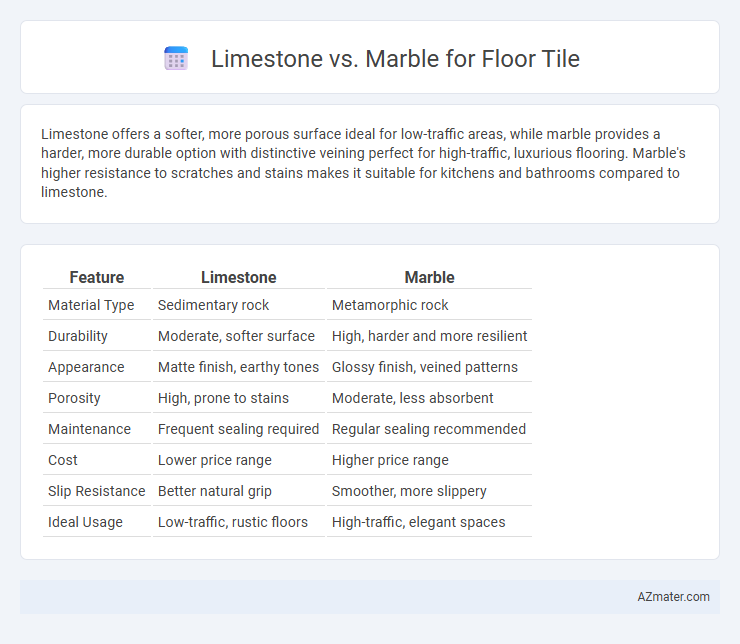Limestone offers a softer, more porous surface ideal for low-traffic areas, while marble provides a harder, more durable option with distinctive veining perfect for high-traffic, luxurious flooring. Marble's higher resistance to scratches and stains makes it suitable for kitchens and bathrooms compared to limestone.
Table of Comparison
| Feature | Limestone | Marble |
|---|---|---|
| Material Type | Sedimentary rock | Metamorphic rock |
| Durability | Moderate, softer surface | High, harder and more resilient |
| Appearance | Matte finish, earthy tones | Glossy finish, veined patterns |
| Porosity | High, prone to stains | Moderate, less absorbent |
| Maintenance | Frequent sealing required | Regular sealing recommended |
| Cost | Lower price range | Higher price range |
| Slip Resistance | Better natural grip | Smoother, more slippery |
| Ideal Usage | Low-traffic, rustic floors | High-traffic, elegant spaces |
Introduction to Limestone and Marble Flooring
Limestone flooring offers natural durability and a soft, earthy texture, making it ideal for creating warm, inviting spaces with subtle color variations. Marble flooring is prized for its elegant, polished finish and distinctive veining patterns, providing a luxurious and timeless aesthetic. Both materials require proper sealing to protect against stains and moisture, ensuring long-lasting beauty and functionality in residential and commercial spaces.
Key Differences Between Limestone and Marble
Limestone, a sedimentary rock, features a softer and more porous texture compared to marble, which is a metamorphic rock with a denser and more crystalline structure. Marble offers greater durability and resistance to scratches and stains, making it suitable for high-traffic floor areas, while limestone requires more maintenance due to its susceptibility to absorption and etching. The visual difference lies in limestone's matte, earthy tones versus marble's polished, veined appearance, influencing aesthetic choice for flooring applications.
Appearance and Aesthetic Appeal
Limestone offers a natural, earthy appearance with soft, muted tones and subtle textures that enhance rustic or traditional interior designs, while marble is prized for its luxurious, polished finish and distinctive veining patterns that create a sophisticated and elegant atmosphere. The color variations in marble range from crisp whites to deep greens and rich blacks, adding dynamic visual interest to any space, whereas limestone's more uniform shades provide a warm, timeless look. Both materials age beautifully, but marble's reflective surface tends to brighten rooms and accentuate architectural details, making it ideal for upscale flooring applications.
Durability and Longevity
Limestone floor tiles offer moderate durability, being softer and more porous, which makes them prone to scratches and stains without proper sealing, while marble provides higher durability with a denser structure and greater resistance to wear and tear. Marble's natural crystalline composition contributes to its longevity, often lasting decades in high-traffic areas when properly maintained, whereas limestone may require more frequent repairs or replacement due to its vulnerability to chipping and erosion. Both materials benefit from regular sealing, but marble is generally preferred for long-term performance in flooring applications due to its superior strength and resistance to moisture.
Maintenance and Cleaning Requirements
Limestone floor tiles demand gentle cleaning with pH-neutral cleaners to avoid surface etching, while marble requires regular sealing to protect its porous surface from stains and moisture. Both materials are sensitive to acidic substances, so spills from vinegar or citrus should be wiped immediately to prevent damage. Routine dusting and the use of soft mops help maintain the polished finish and extend the lifespan of limestone and marble floor tiles.
Cost Comparison: Limestone vs Marble
Limestone floor tiles generally cost between $5 to $15 per square foot, making them a more budget-friendly option compared to marble, which typically ranges from $10 to $30 per square foot. The price difference largely reflects marble's higher density, durability, and distinctive veining patterns that enhance luxury appeal. Installation and maintenance costs also vary, with marble requiring more specialized care and sealing to preserve its appearance over time.
Installation Process and Considerations
Limestone and marble floor tiles require different installation processes due to their distinct physical properties; limestone is softer and more porous, necessitating a thorough sealing before and after installation to prevent staining and moisture damage, while marble demands careful handling to avoid chipping and etching. Both materials require a stable, level substrate, but marble installation often benefits from professional cutting and polishing to enhance its natural veining and shine. Proper maintenance considerations include using pH-neutral cleaners for marble and routine resealing for limestone to ensure durability and preserve aesthetic appeal.
Suitable Applications in Home and Commercial Spaces
Limestone flooring offers a durable and natural look ideal for low-traffic home areas such as living rooms and bedrooms, while its slip resistance makes it suitable for patios and outdoor commercial spaces. Marble tiles provide a luxurious and elegant finish best suited for high-end residential foyers, bathrooms, and commercial lobbies, where aesthetic appeal is a priority despite requiring more maintenance. Both materials accommodate radiant heating systems, enhancing comfort in various settings from homes to upscale retail environments.
Environmental Impact and Sustainability
Limestone floor tiles have a lower environmental impact due to their abundant availability and lower energy requirements during quarrying and processing, making them a more sustainable choice. Marble, while visually appealing, involves more intensive mining and higher energy consumption, contributing to greater carbon emissions and environmental degradation. Both materials are natural stones, but limestone's ecological footprint is significantly smaller, promoting sustainability in flooring applications.
Choosing the Right Material for Your Floor Tile
Limestone offers a natural, porous surface that provides a warm, rustic look ideal for low-traffic areas, while marble features a denser, polished finish with unique veining patterns suited for elegant, high-traffic spaces. Consider factors like durability, maintenance requirements, and slip resistance when choosing between limestone and marble for floor tiles. Selecting the right material depends on the desired aesthetic, budget, and functional needs of the flooring environment.

Infographic: Limestone vs Marble for Floor Tile
 azmater.com
azmater.com